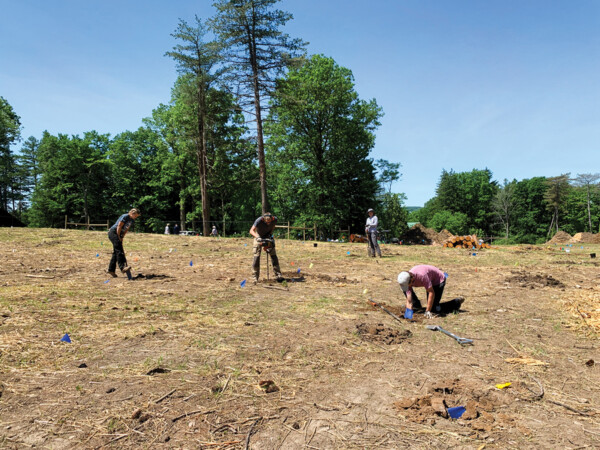The Lafayette Road Experiment Station (LRES) is getting a makeover. The once heavily wooded 44-acre plot is at the root of a mighty crusade: restore the American chestnut.
The first step, which began in spring 2020, was to create the necessary infrastructure.
An access road and log landing were created, leading from below the barn into the middle of the property enabling loggers to transform the site into discreet areas, each destined for specific purposes.
The first two areas have been designated as shelterwood restorations. Understory, such as invasive buckthorn and poison ivy, was removed so the trees have less competition for resources.
Another component that influences the success of a shelterwood is the amount of light. In spots where the canopy was particularly heavy, researchers identified specific trees to remove, allowing additional light to penetrate the canopies and nourish the seedlings.
Each shelterwood area had a prescription that retained different amounts of canopy based on how many overstory trees remain. Paths with signage will wind through the new chestnut/oak/hickory restoration demonstration. This will allow the public as well as researchers to compare and contrast how chestnut grows under different light levels.
“We didn’t just do a clear cut in this area,” said Dr. William Powell, co-director of the American Chestnut Research & Restoration Project. “We knew we would be planting American chestnut seedlings in this area, but we wanted to integrate the American chestnut into a forest. We left many of the older trees, and our hope is that the chestnuts will grow alongside of them.”
The re-imagined LRES encourages agroforestry demonstrations using dual cropping. In one area, the American chestnut and the American/European hybrid are mixed to create a chestnut orchard. According to the Agricultural Marketing Resource Center, the United States is one of the few nations in the world that
can grow chestnuts, yet doesn’t have a significant chestnut industry. United States chestnut production is less than 1 percent of total world production, with 919 farms producing chestnuts on more than 3,700 acres. Currently, New York is not listed among the top five chestnut-producing states. Researchers at the LRES aim to change these statistics.
The second orchard is dedicated to mixed crops.
“One ESF faculty member is doing a mixed orchard with chestnut trees and grapevines,” said Powell. “This is done in Spain, and there is a clear economic advantage to this type of ‘tree-to-table’ farming.”
The final area of the new LRES will be a demonstration area, where visitors can come to learn about the research that supported the American chestnut restoration, discover interesting facts about the tree that was almost rendered extinct, and engage in some interactive exhibits.
This work was made possible by a $3.2 million gift from the Templeton World Charity Foundation, the College’s largest ever charitable gift. The Templeton World Charity funds scientific breakthroughs and development of practical tools relating to the search for meaning, purpose and truth. The charity describes itself as serving as “a global philanthropic catalyst for discoveries relating to Big Questions of life and the universe, in areas of science, theology, philosophy, and human society.”
Dana Piwinski ’80, senior director of major gifts for ESF, emphasized what a great partner Templeton World Charity Foundation has been over the past several years with prior grants to the effort. “This new exceptional level of support is truly enabling the restoration phase of the project to begin in earnest,” he said.
Stephanie Specchio is the associate vice president of communications and marketing at ESF.
All this students were involved in writing explanatory essay for the vacation brake



